Abstract
Pilot appraisals of the activities of 16 specially selected 9-phenanthrenemethanols against acute infections with Plasmodium falciparum in owl monkeys showed that all were more active than the reference compound, WR-33,063. WR-122,455, the most active derivative, and WR-171,669, ranked sixth, were selected for study in human volunteers. To assist this undertaking, appraisals of both compounds in owl monkeys infected with various strains of P. falciparum were expanded. These assessments showed: (i) that WR-122,455 was four times as active as chloroquine against infections with chloroquine-sensitive strains and that WR-171,669 equalled chloroquine in activity; (ii) that these compounds were fully active against infections with strains resistant to chloroquine, pyrimethamine, or quinine, or to all three standard drugs; (iii) that the activity of WR-122,455 was a function of total dose, single doses being as effective as the same amounts delivered in three or seven daily fractions; and (iv) that a single dose of WR-122,455 conferred extended, although only partial, protection against challenges with trophozoites. Complementary experiments in rhesus monkeys inoculated with sporozoites of P. cynomolgi showed that the activity of WR-122,455 was limited to blood schizonts and did not extend to early or late tissue schizonts. These evaluations were compatible with the results of preliminary studies of the activities of WR-122,455 and WR-171,669 in human volunteers.
Full text
PDF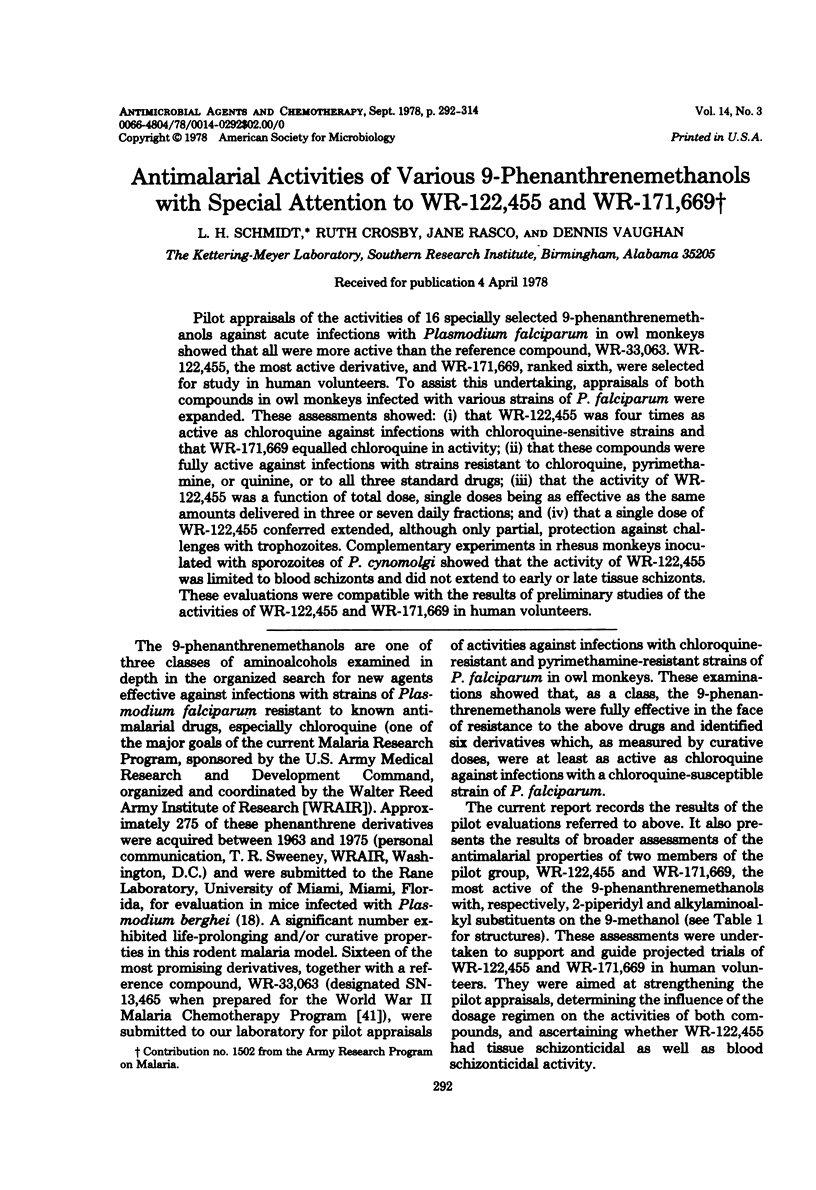
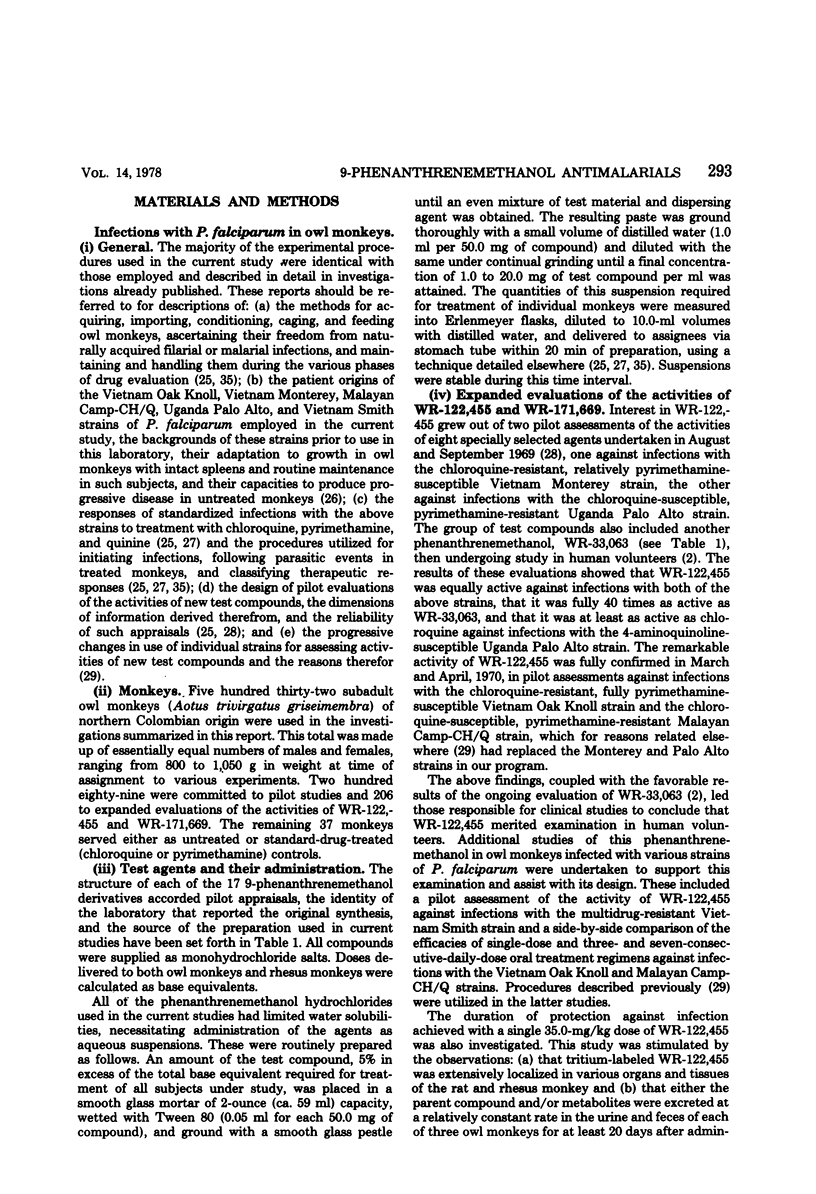
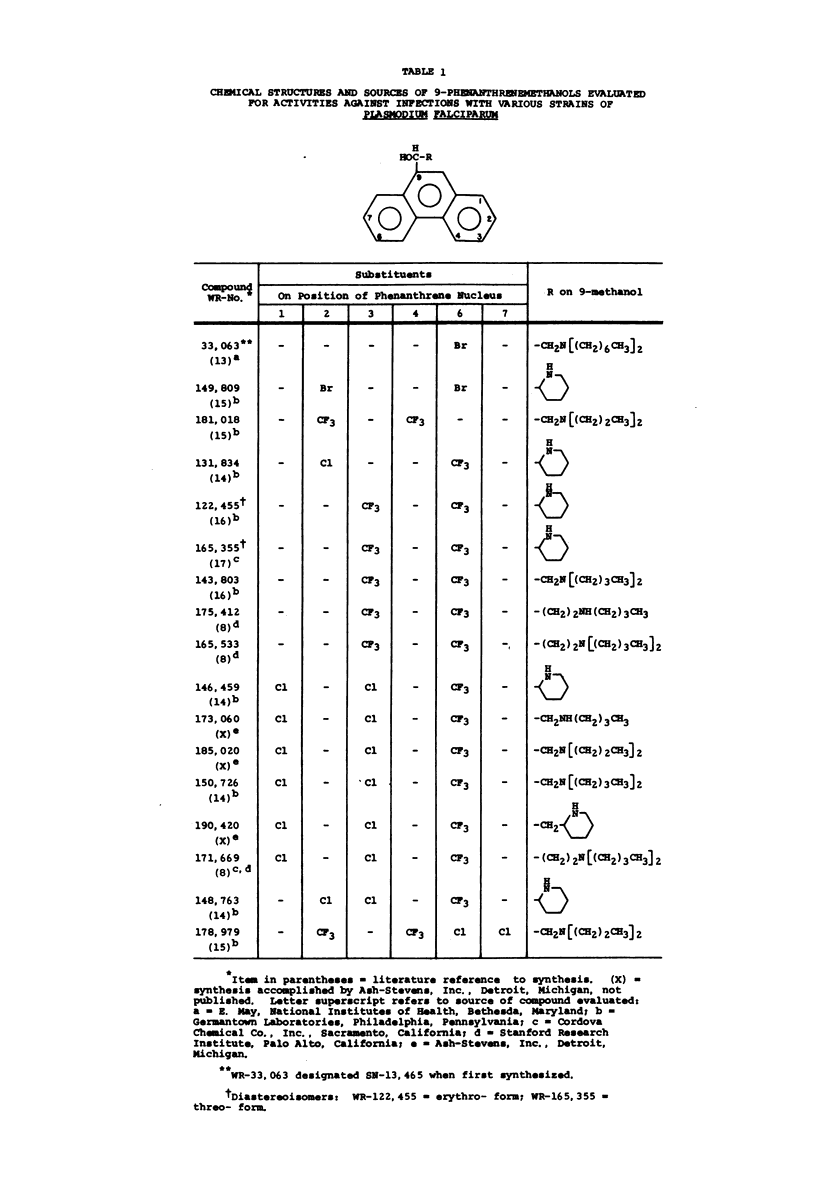
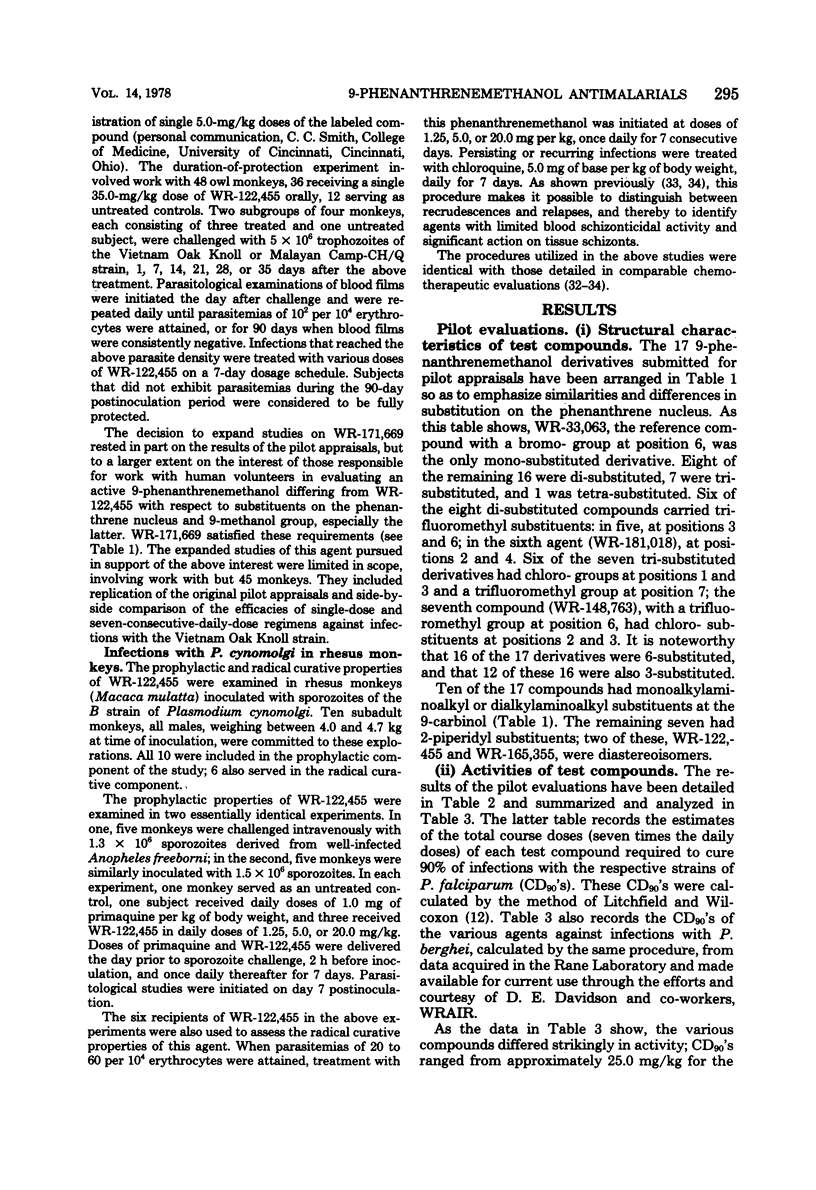
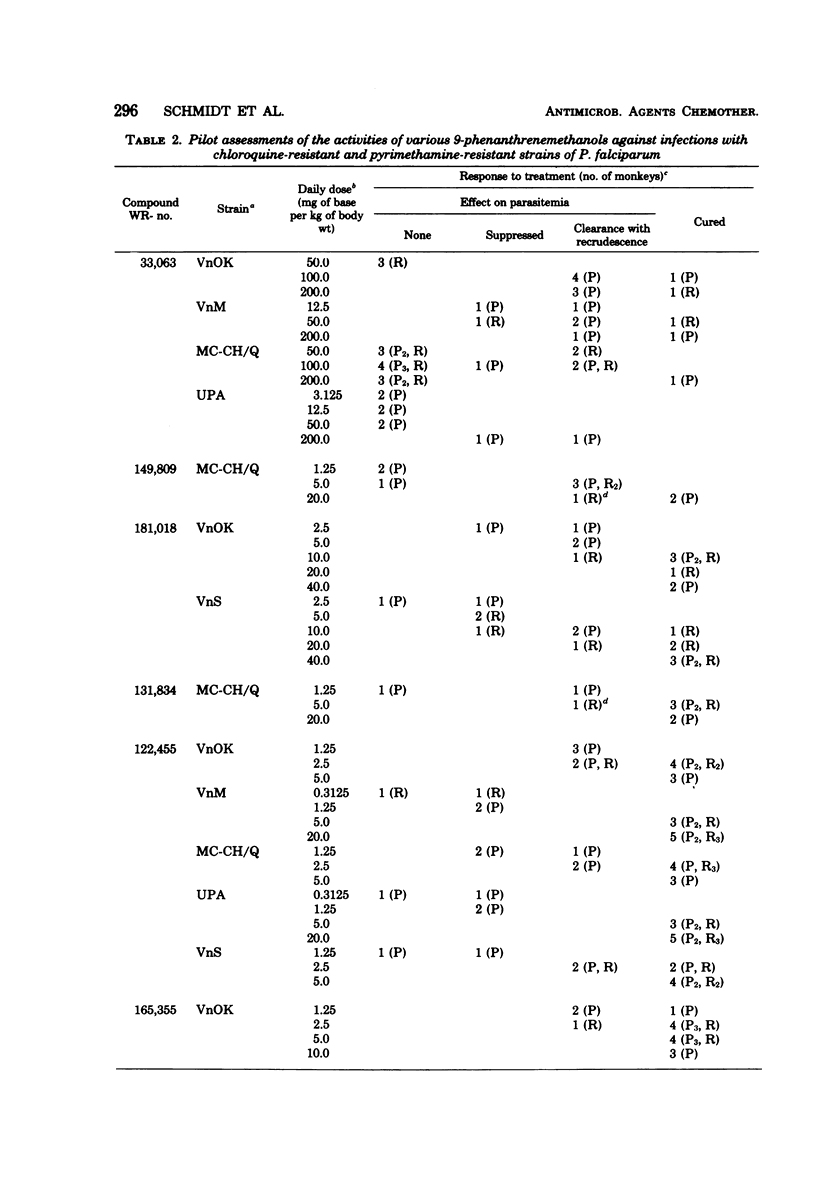
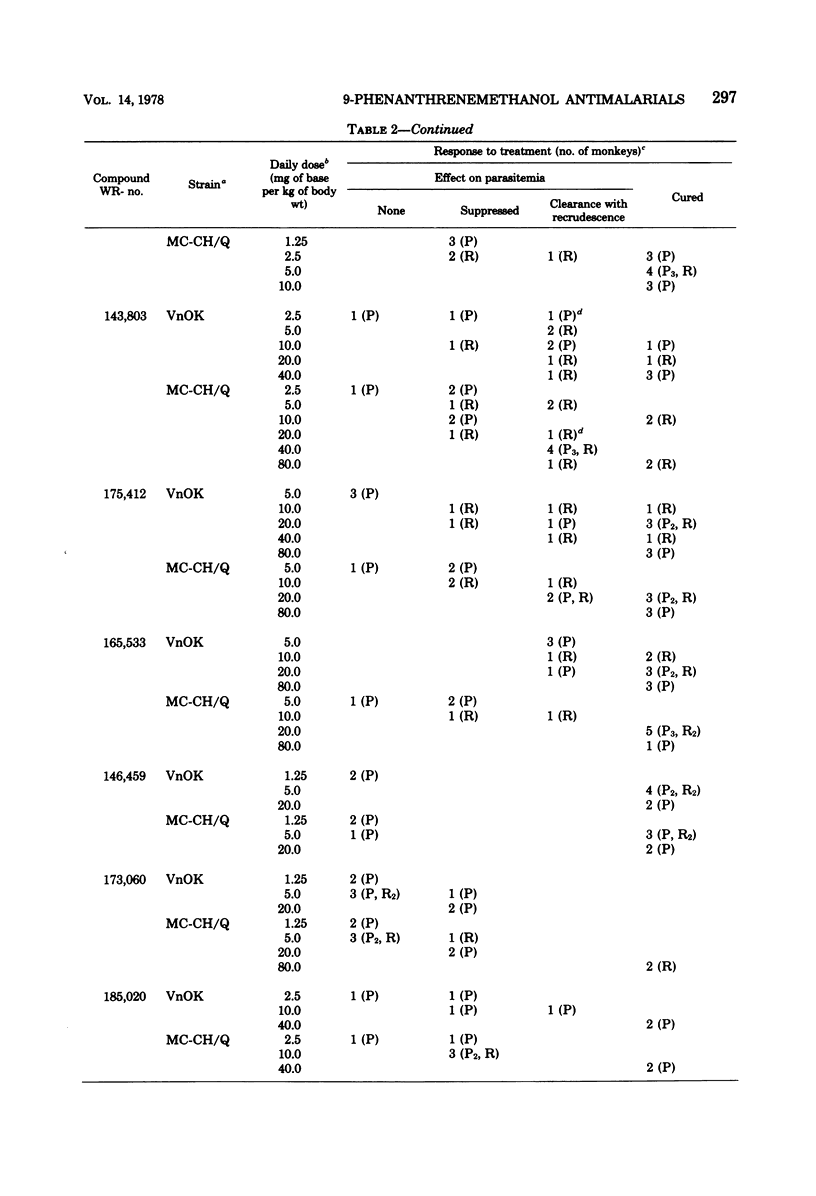
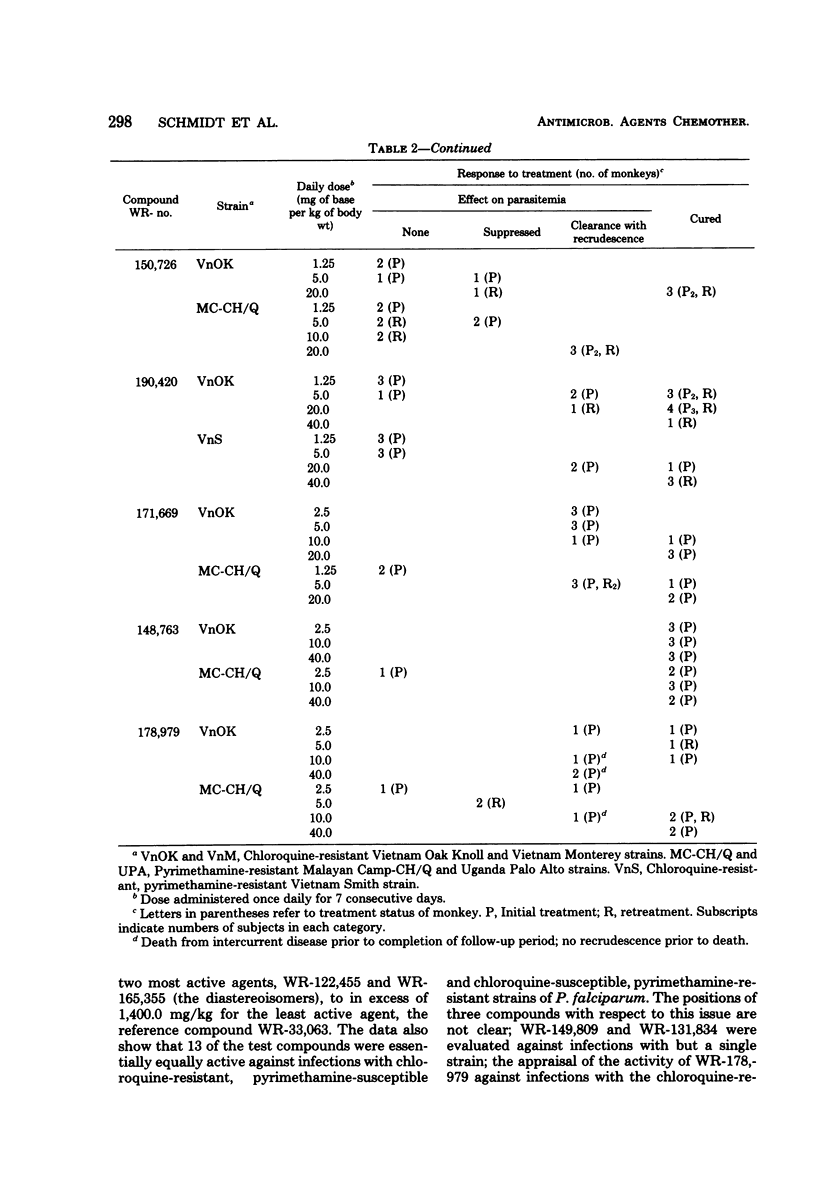
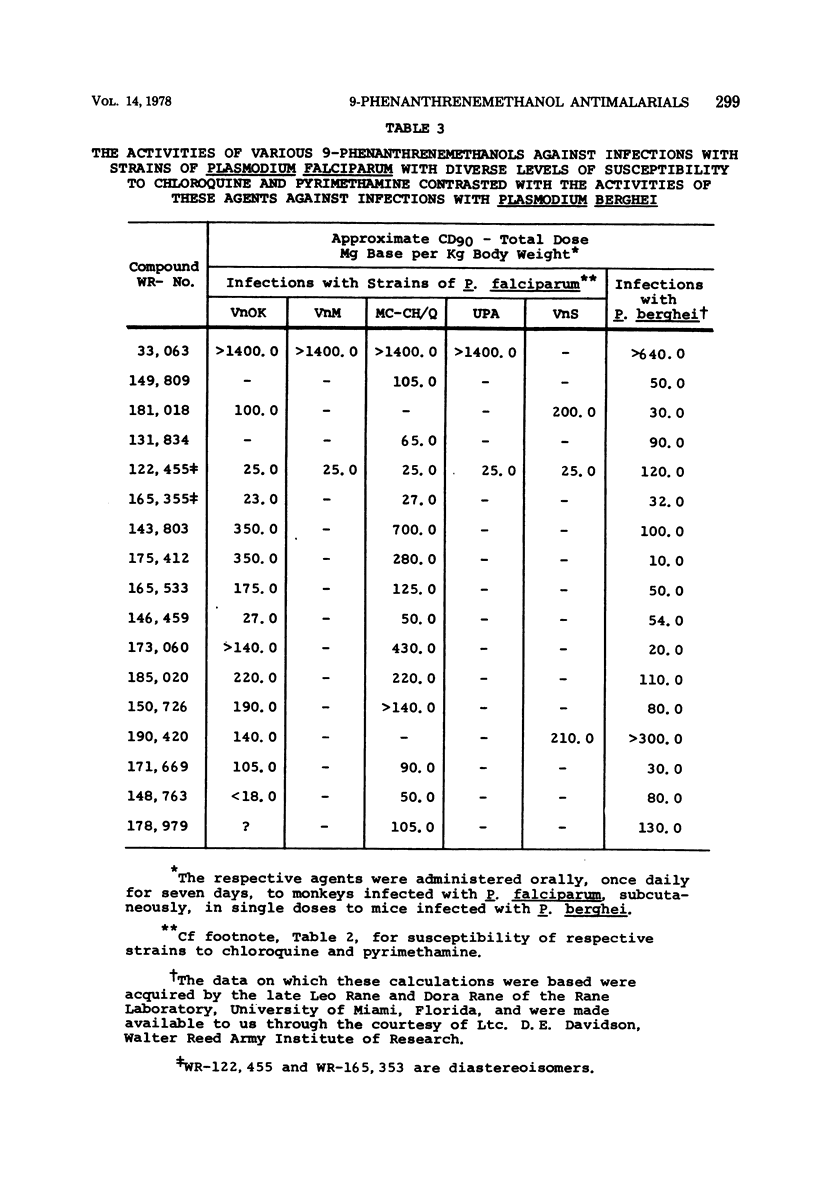
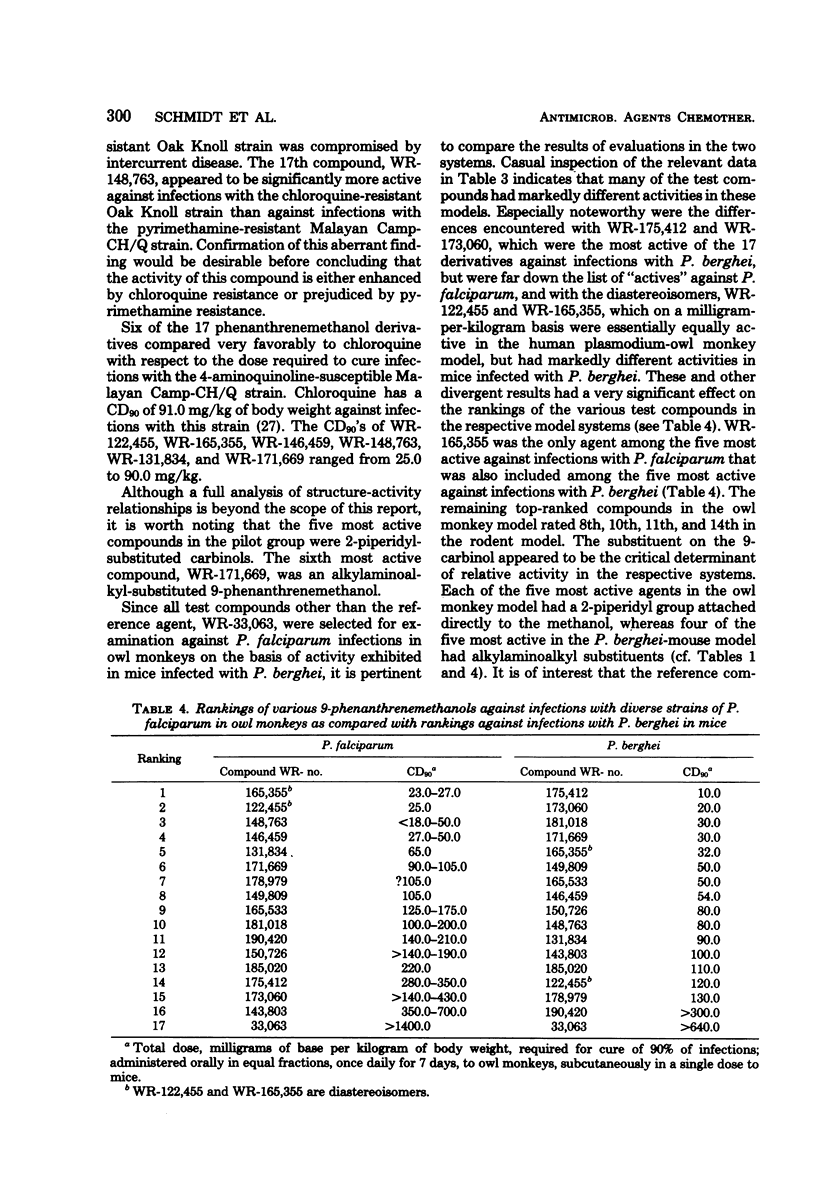
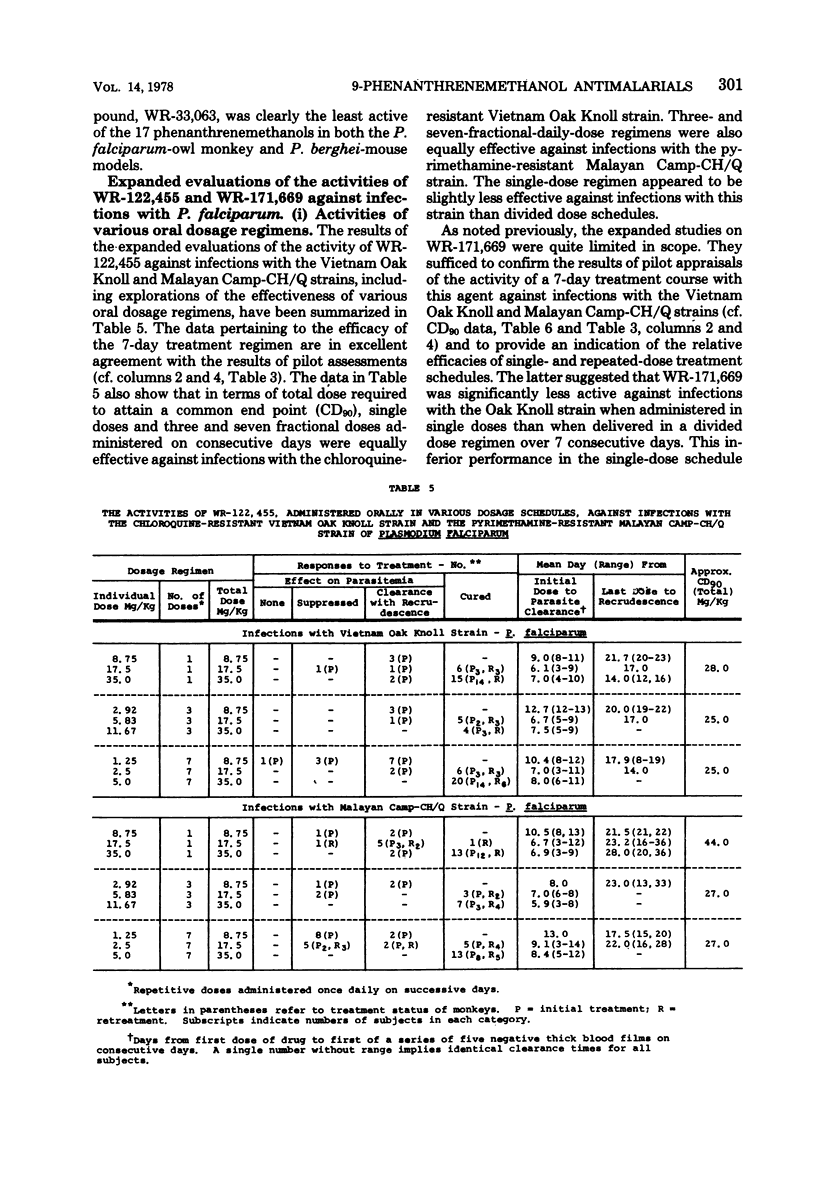
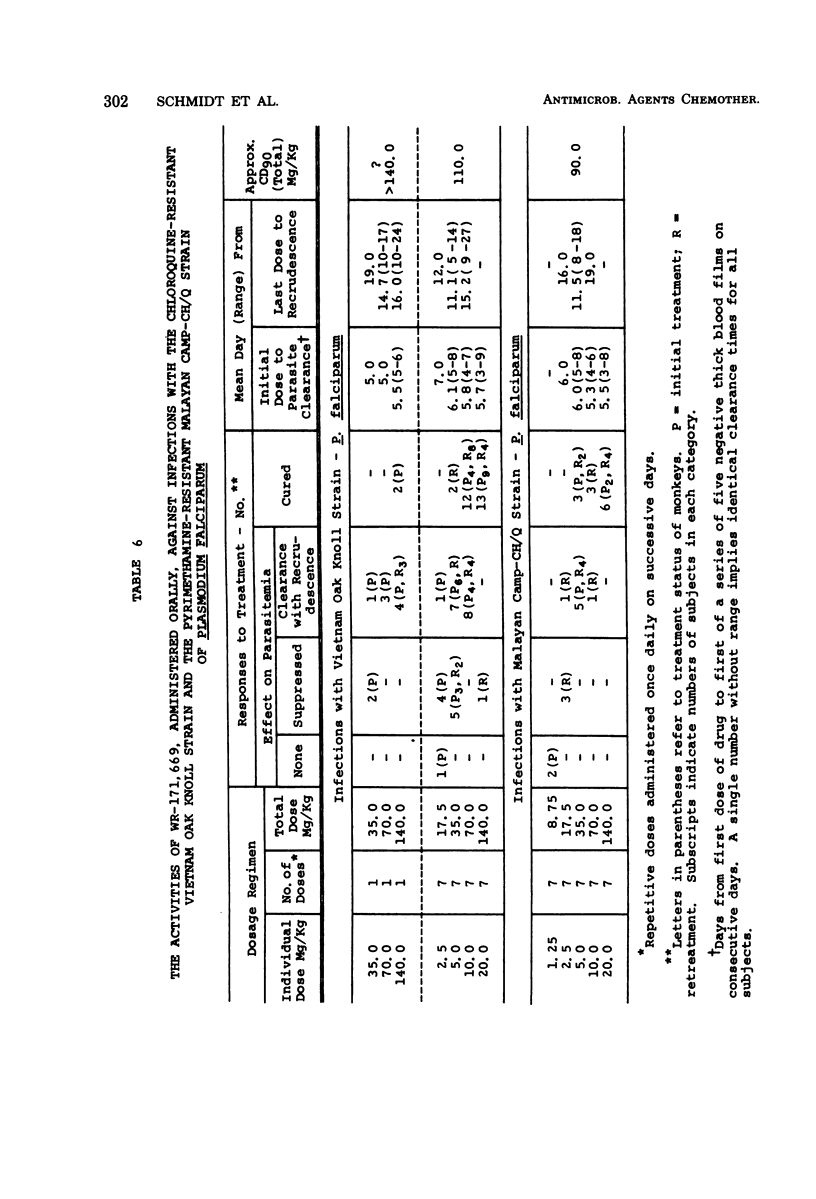
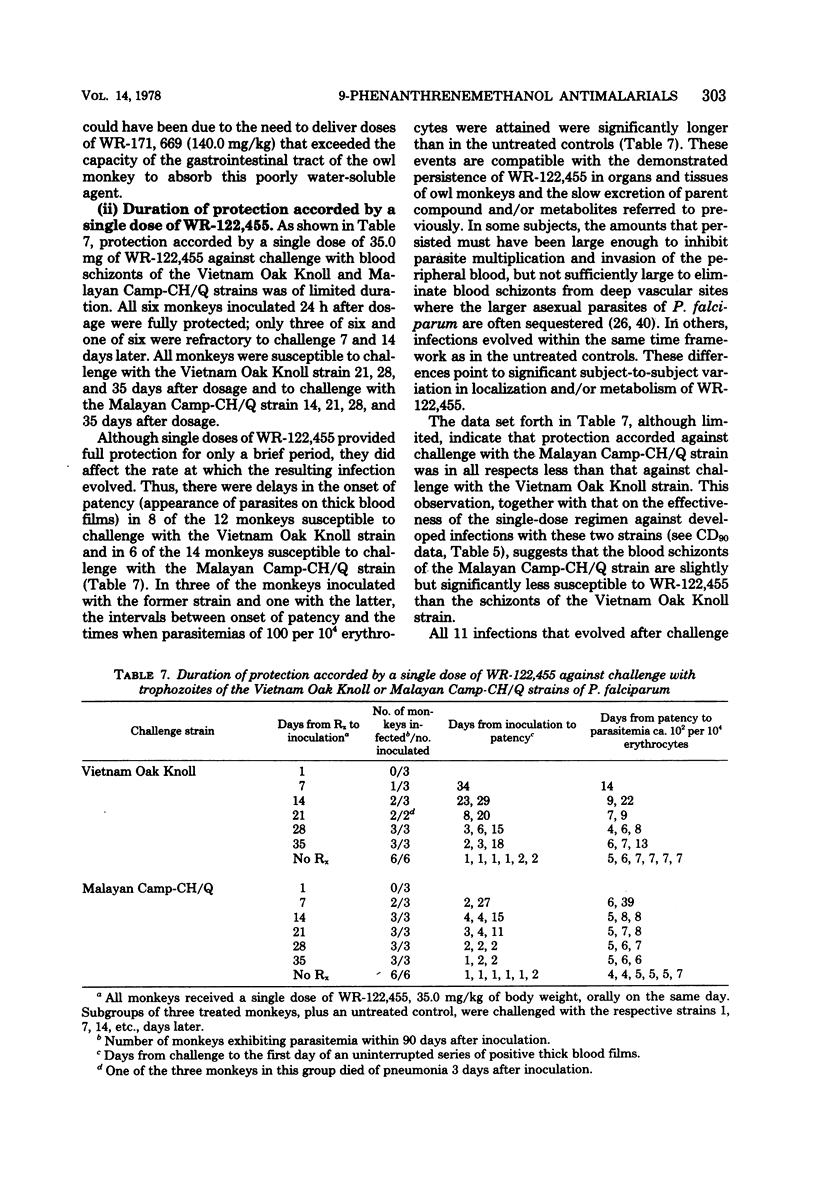
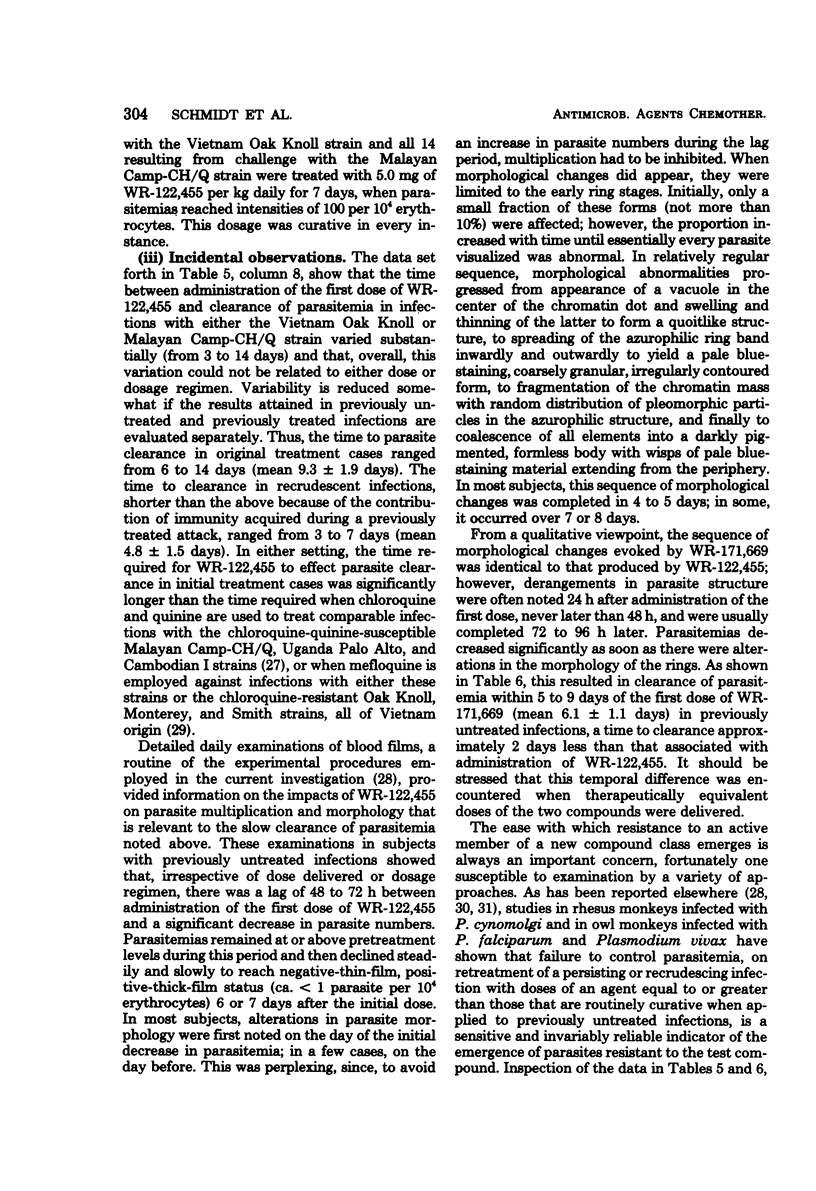

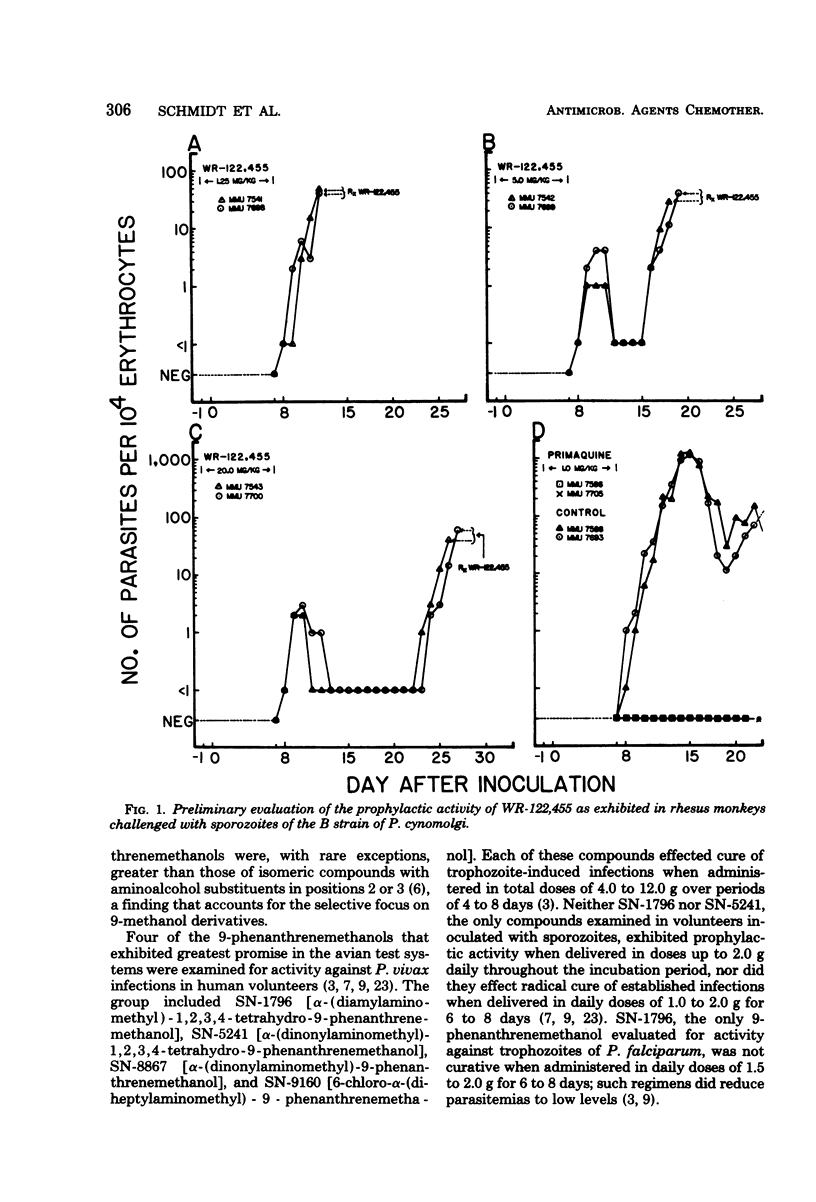
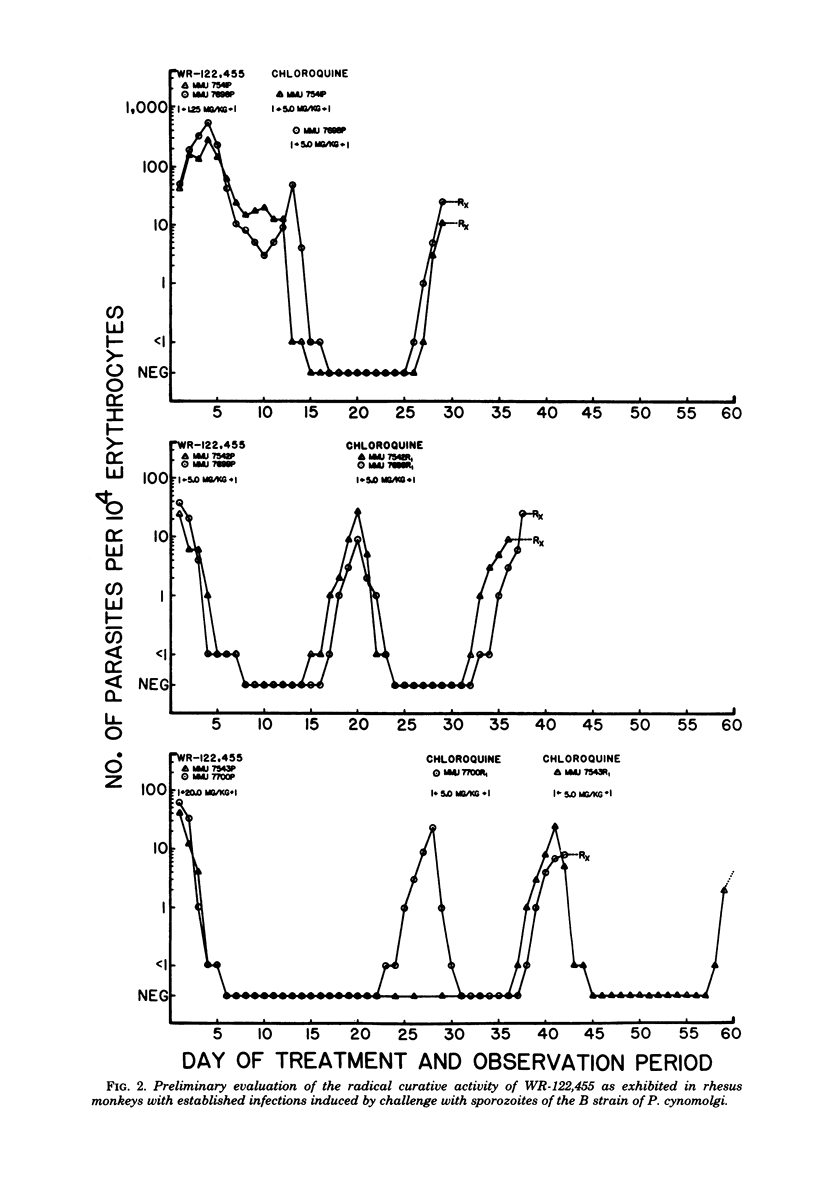
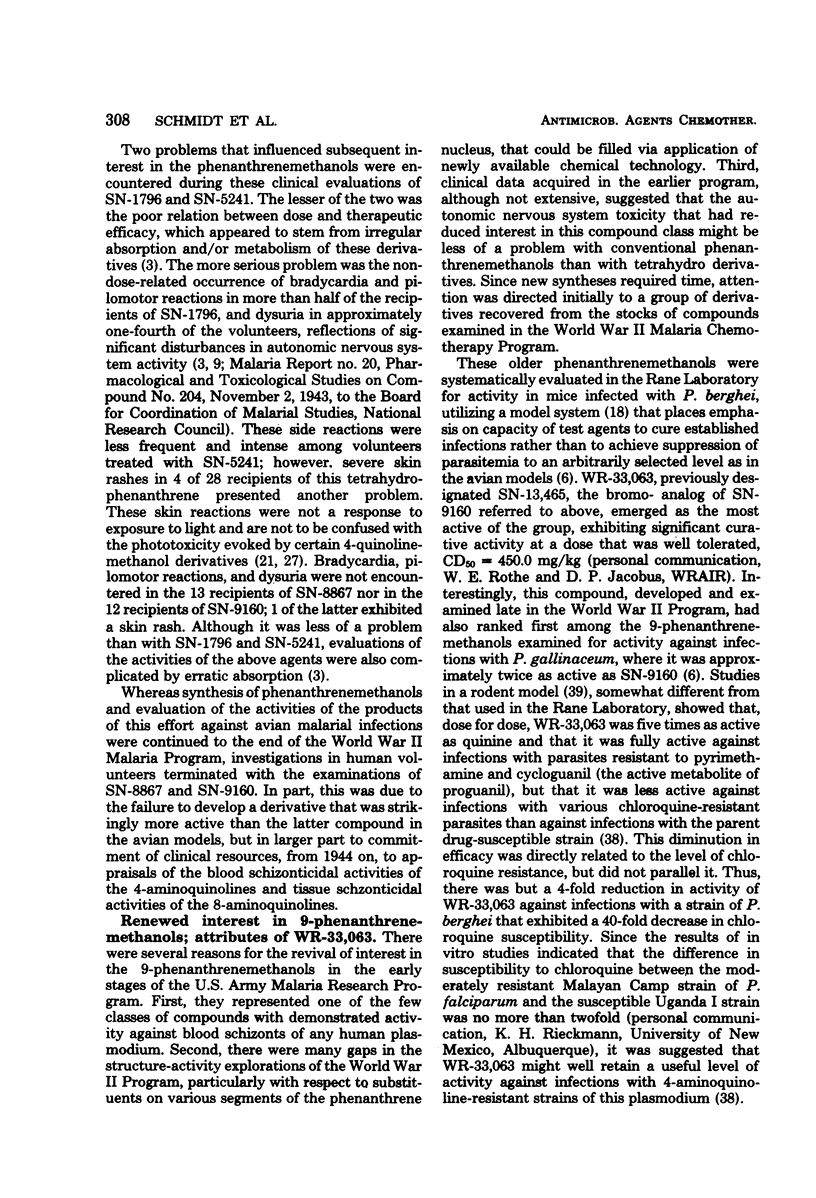
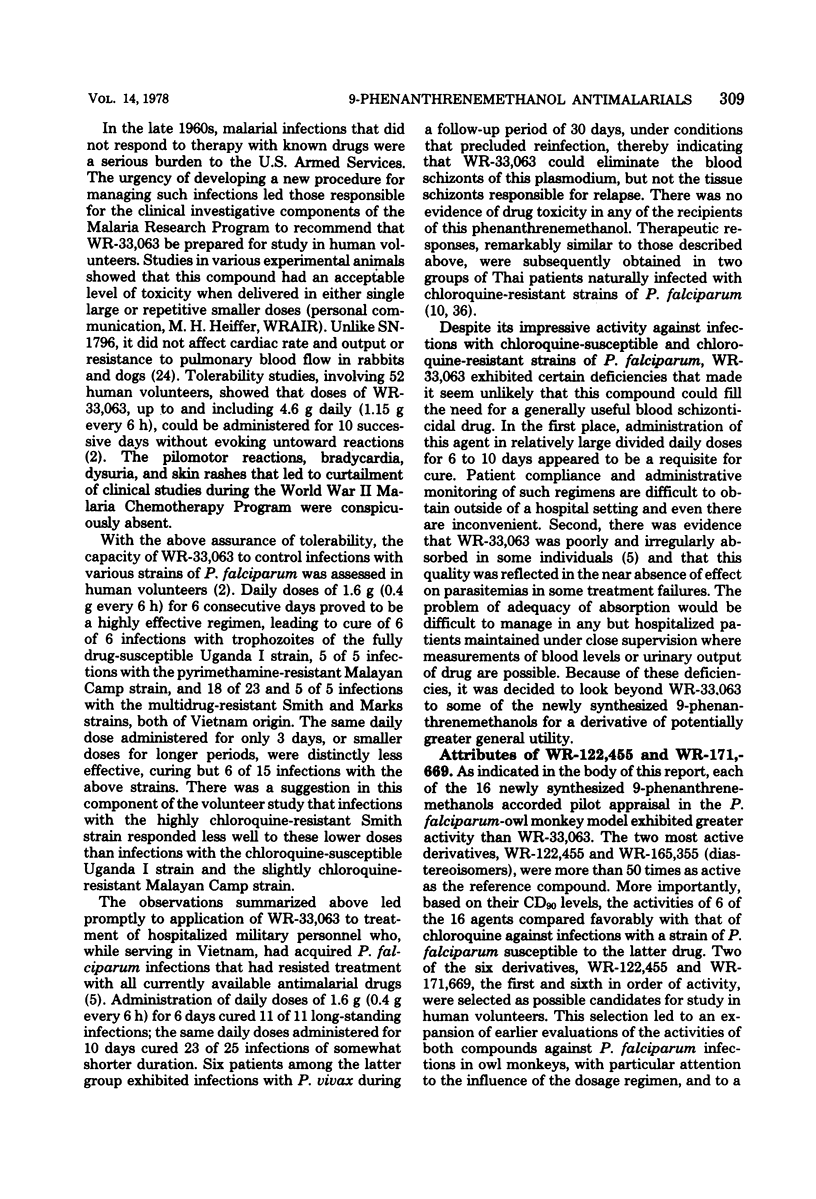
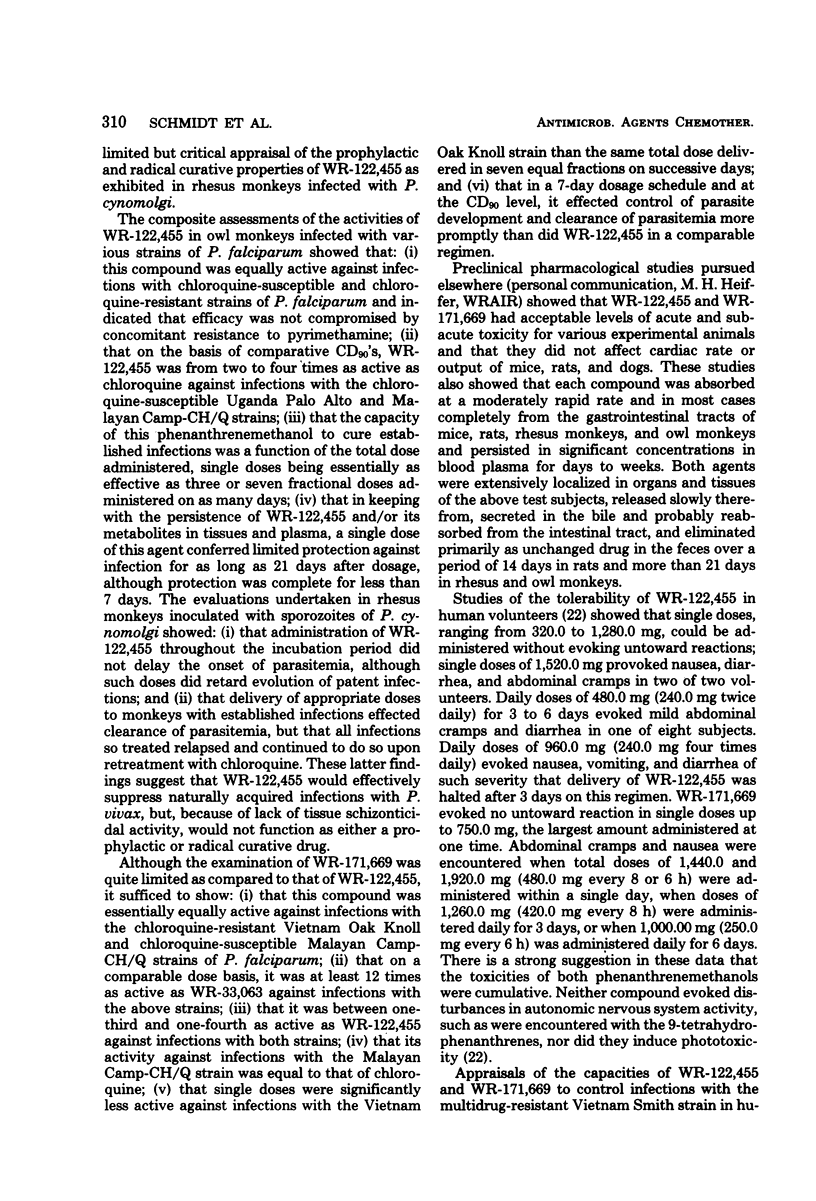
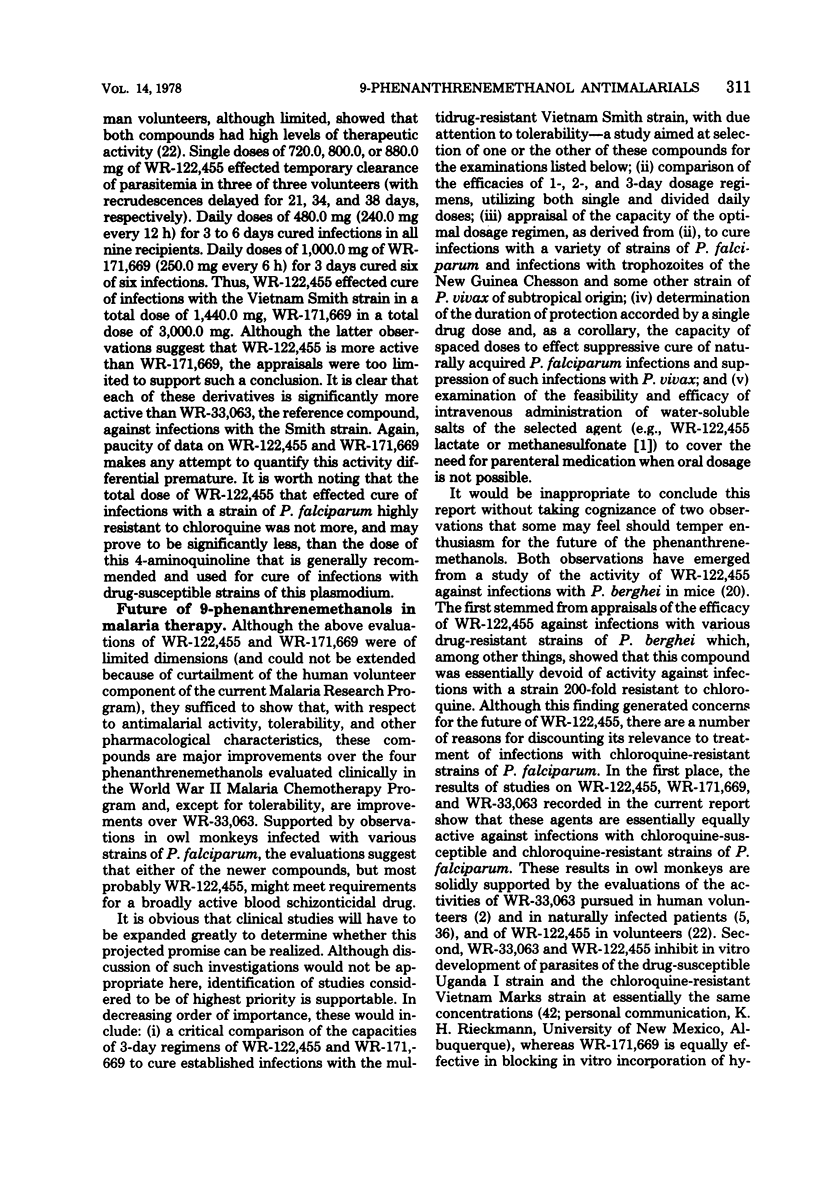
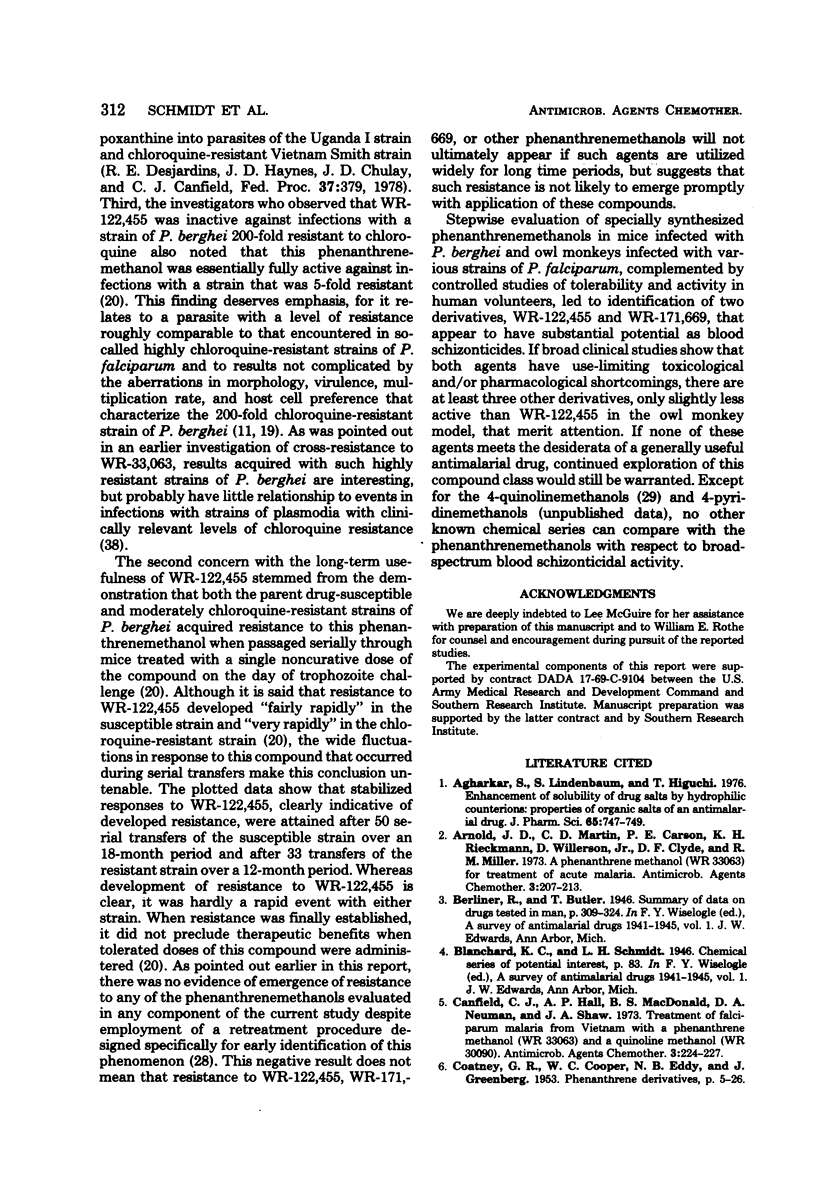
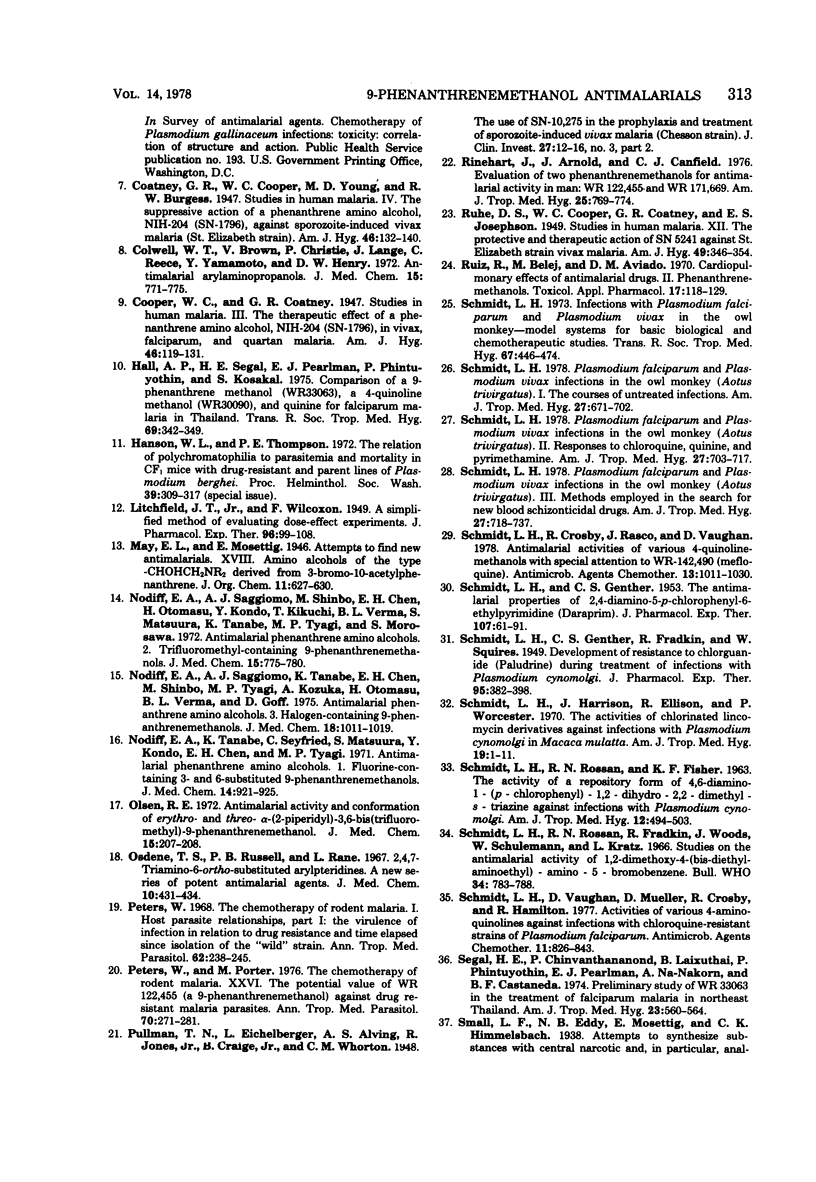
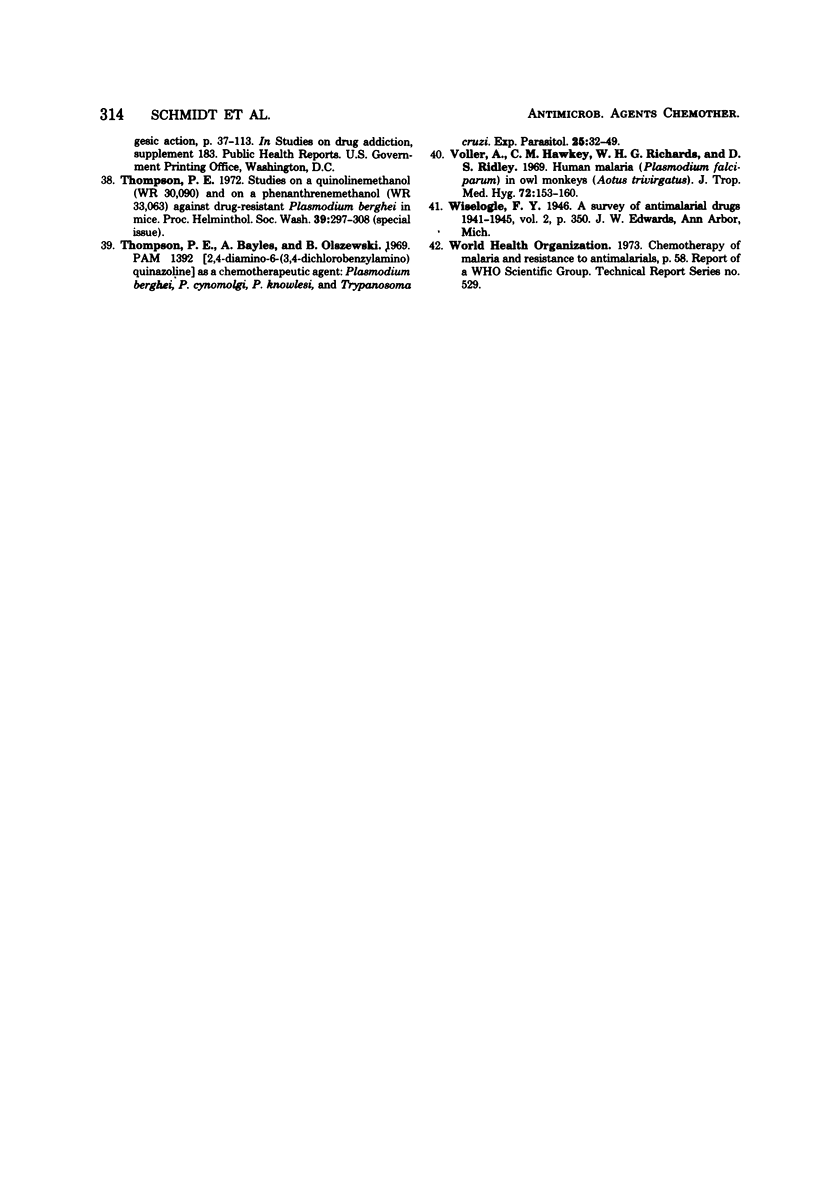
Selected References
These references are in PubMed. This may not be the complete list of references from this article.
- Agharkar S., Lindenbaum S., Higuchi T. Enhancement of solubility of drug salts by hydrophilic counterions: properties of organic salts of an antimalarial drug. J Pharm Sci. 1976 May;65(5):747–749. doi: 10.1002/jps.2600650533. [DOI] [PubMed] [Google Scholar]
- Arnold J. D., Martin D. C., Carson P. E., Rieckmann K. H., Willerson D., Jr, Clyde D. F., Miller R. M. A phenanthrene methanol (WR 33063) for treatment of acute malaria. Antimicrob Agents Chemother. 1973 Feb;3(2):207–213. doi: 10.1128/aac.3.2.207. [DOI] [PMC free article] [PubMed] [Google Scholar]
- Canfield C. J., Hall A. P., MacDonald B. S., Neuman D. A., Shaw J. A. Treatment of falciparum malaria from Vietnam with a phenanthrene methanol (WR 33063) and a quinoline methanol (WR 30090). Antimicrob Agents Chemother. 1973 Feb;3(2):224–227. doi: 10.1128/aac.3.2.224. [DOI] [PMC free article] [PubMed] [Google Scholar]
- Colwell W. T., Brown V., Christie P., Lange J., Reece C., Yamamoto K., Henry D. W. Antimalarial arylaminopropanols. J Med Chem. 1972 Jul;15(7):771–775. doi: 10.1021/jm00277a018. [DOI] [PubMed] [Google Scholar]
- Hall A. P., Segal H. E., Pearlman E. J., Phintuyothin P. Comparison of a 9-phenanthrene methanol (WR33063), a 4-quinoline methanol (WR30090), and quinine for falciparum malaria in Thailand. Trans R Soc Trop Med Hyg. 1975;69(3):342–349. doi: 10.1016/0035-9203(75)90129-7. [DOI] [PubMed] [Google Scholar]
- Nodiff E. A., Saggiomo A. J., Shinbo M., Chen E. H., Otomasu H., Kondo Y., Kikuchi T., Verma B. L., Matsuura S., Tanabe K. Antimalarial phenanthrene amino alcohols. 2. Trifluoromethyl-containing 9-phenanthrenemethanols. J Med Chem. 1972 Jul;15(7):775–780. doi: 10.1021/jm00277a019. [DOI] [PubMed] [Google Scholar]
- Nodiff E. A., Saggiomo A. J., Tanabe K., Chen E. H., Shinbo M., Tyagi M. P., Kozuka A., Otomasu H., Verma B. L., Goff D. Antimalarial phenanthrene amino alcohols. 3. Halogen-containing 9-phenanthrenemethanols. J Med Chem. 1975 Oct;18(10):1011–1019. doi: 10.1021/jm00244a012. [DOI] [PubMed] [Google Scholar]
- Nodiff E. A., Tanabe K., Seyfried C., Matsuura S., Kondo Y., Chen E. H., Tyagi M. P. Antimalarial phenanthrene amino alcohols.1. Fluorine-containing 3- and 6-substituted 9-phenanthrenemethanols. J Med Chem. 1971 Oct;14(10):921–925. doi: 10.1021/jm00292a007. [DOI] [PubMed] [Google Scholar]
- Olsen R. E. Antimalarial activity and conformation of erythro- and threo- -(2-piperidyl)-3,6-bis(trifluoromethyl)-9-phenanthrenemethanol. J Med Chem. 1972 Feb;15(2):207–208. doi: 10.1021/jm00272a024. [DOI] [PubMed] [Google Scholar]
- Peters W., Porter M. The chemotherapy of rodent malaria, XXVI. The potential value of WR 122,455 (a 9-phenanthrenemethanol) against drug-resistant malaria parasites. Ann Trop Med Parasitol. 1976 Sep;70(3):271–281. doi: 10.1080/00034983.1976.11687123. [DOI] [PubMed] [Google Scholar]
- Peters W. The chemotherapy of rodent malaria. I. Host-parasite relationships. I. The virulence of infection in relation to drug resistance and time elapsed since isolation of the 'wild' strain. Ann Trop Med Parasitol. 1968 Jun;62(2):238–245. [PubMed] [Google Scholar]
- Pullman T. N., Eichelberger L., Alving A. S., Jones R., Craige B., Whorton C. M. THE USE OF SN-10,275 IN THE PROPHYLAXIS AND TREATMENT OF SPOROZOITE-INDUCED VIV AX MALARIA (CHESSON STRAIN). J Clin Invest. 1948 May;27(3 Pt 2):12–16. doi: 10.1172/JCI101949. [DOI] [PMC free article] [PubMed] [Google Scholar]
- Rinehart J., Arnold J., Canfield C. J. Evaluation of two phenanthrenemethanols for antimalarial activity in man: WR 122,455 and WR 171,669. Am J Trop Med Hyg. 1976 Nov;25(6):769–774. doi: 10.4269/ajtmh.1976.25.769. [DOI] [PubMed] [Google Scholar]
- Ruiz R., Belej M., Aviado D. M. Cardiopulmonary effects of antimalarial drugs. II. Phenanthrenemethanols. Toxicol Appl Pharmacol. 1970 Jul;17(1):118–129. doi: 10.1016/0041-008x(70)90137-7. [DOI] [PubMed] [Google Scholar]
- SCHMIDT L. H., GENTHER C. S. The antimalarial properties of 2, 4-diamino-5-p-chlorophenyl-6-ethylpyrimidine, daraprim. J Pharmacol Exp Ther. 1953 Jan;107(1):61–91. [PubMed] [Google Scholar]
- SCHMIDT L. H., ROSSAN R. N., FISHER K. F. THE ACTIVITY OF A REPOSITORY FORM OF 4,6-DIAMINO-1(P-CHLOROPHENYL)-1,2-DIHYDRO-2,2-DIMETHYL-S-TRIAZINE AGAINST INFECTIONS WITH PLASMODIUM CYNOMOLGI. Am J Trop Med Hyg. 1963 Jul;12:494–503. doi: 10.4269/ajtmh.1963.12.494. [DOI] [PubMed] [Google Scholar]
- Schmidt L. H., Crosby R., Rasco J., Vaughan D. Antimalarial activities of various 4-quinolonemethanols with special attention to WR-142,490 (mefloquine). Antimicrob Agents Chemother. 1978 Jun;13(6):1011–1030. doi: 10.1128/aac.13.6.1011. [DOI] [PMC free article] [PubMed] [Google Scholar]
- Schmidt L. H., Harrison J., Ellison R., Worcester P. The activities of chlorinated lincomycin derivatives against infections with Plasmodium cynomolgi in Macaca mulatta. Am J Trop Med Hyg. 1970 Jan;19(1):1–11. doi: 10.4269/ajtmh.1970.19.1. [DOI] [PubMed] [Google Scholar]
- Schmidt L. H. Infections with Plasmodium falciparum and Plasmodium vivax in the owl monkey--model systems for basic biological and chemotherapeutic studies. Trans R Soc Trop Med Hyg. 1973;67(4):446–474. doi: 10.1016/0035-9203(73)90077-1. [DOI] [PubMed] [Google Scholar]
- Schmidt L. H. Plasmodium falciparum and Plasmodium vivax infections in the owl monkey (Aotus trivirgatus). I. The courses of untreated infections. Am J Trop Med Hyg. 1978 Jul;27(4):671–702. doi: 10.4269/ajtmh.1978.27.671. [DOI] [PubMed] [Google Scholar]
- Schmidt L. H. Plasmodium falciparum and Plasmodium vivax infections in the owl monkey (Aotus trivirgatus). II. Responses to chloroquine, quinine, and pyrimethamine. Am J Trop Med Hyg. 1978 Jul;27(4):703–717. doi: 10.4269/ajtmh.1978.27.703. [DOI] [PubMed] [Google Scholar]
- Schmidt L. H. Plasmodium falciparum and Plasmodium vivax infections in the owl monkey (Aotus trivirgatus). III. Methods employed in the search for new blood schizonticidal drugs. Am J Trop Med Hyg. 1978 Jul;27(4):718–737. doi: 10.4269/ajtmh.1978.27.718. [DOI] [PubMed] [Google Scholar]
- Schmidt L. H., Rossan R. N., Fradkin R., Woods J., Schulemann W., Kratz L. Studies on the antimalarial activity of 1,2-dimethoxy-4-(bis-diethylaminoethyl)-amino-5-bromobenzene. Bull World Health Organ. 1966;34(5):783–788. [PMC free article] [PubMed] [Google Scholar]
- Schmidt L. H., Vaughan D., Mueller D., Crosby R., Hamilton R. Activities of various 4-aminoquinolines against infections with chloroquine-resistant strains of Plasmodium falciparum. Antimicrob Agents Chemother. 1977 May;11(5):826–843. doi: 10.1128/aac.11.5.826. [DOI] [PMC free article] [PubMed] [Google Scholar]
- Segal H. E., Chinvanthananond P., Laixuthai B., Phintuyothin P., Pearlman E. J., Na-Nakorn A., Castaneda B. F. Preliminary study of WR 33063 in the treatment of falciparum malaria in northeast Thailand. Am J Trop Med Hyg. 1974 Jul;23(4):560–564. doi: 10.4269/ajtmh.1974.23.560. [DOI] [PubMed] [Google Scholar]
- Voller A., Hawkey C. M., Richards W. H., Ridley D. S. Human malaria (Plasmodium falciparum) in owl monkeys (Aotus trivirgatus). J Trop Med Hyg. 1969 Jul;72(7):153–160. [PubMed] [Google Scholar]


